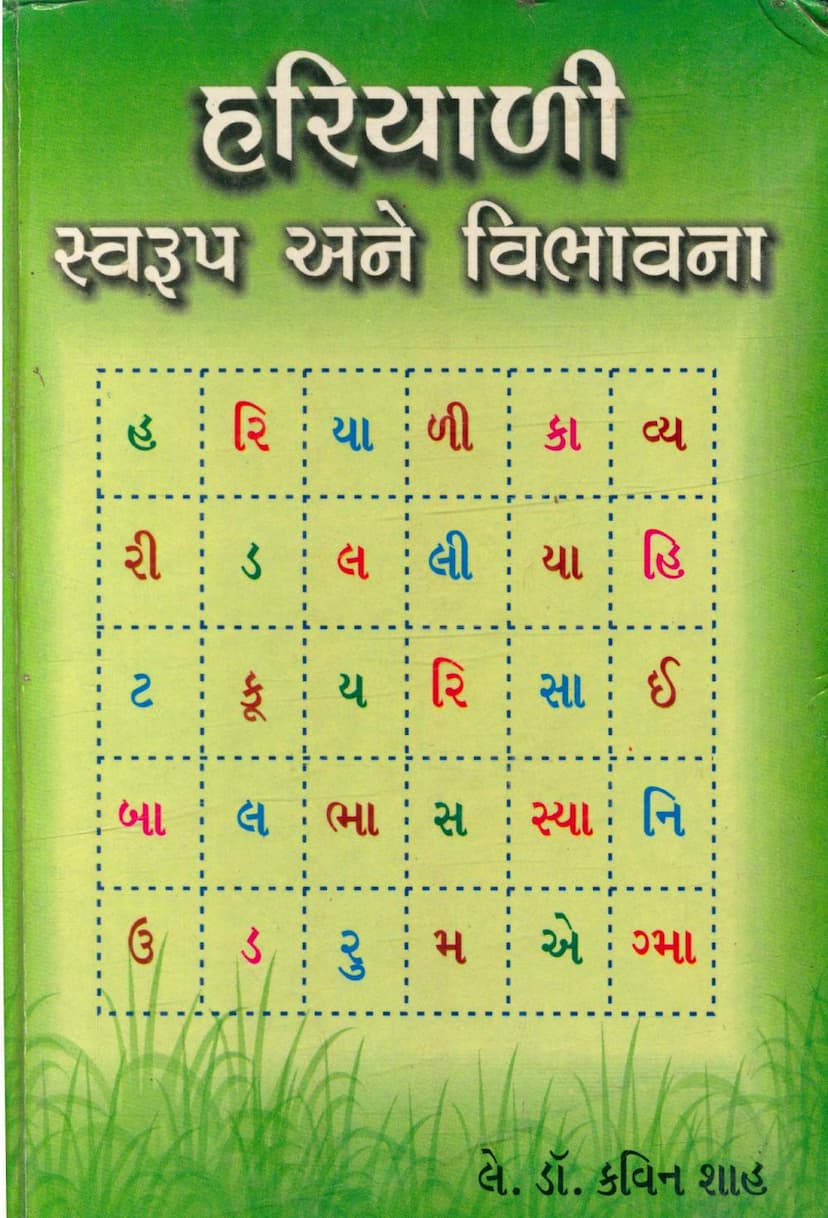Hariyali Swarup Ane Vibhavna
Added to library: September 1, 2025

Summary
Here's a comprehensive summary of the Jain text "Hariyali Swarup Ane Vibhavna" by Kavin Shah, based on the provided pages:
Book Title: Hariyali Swarup Ane Vibhavna (The Form and Conception of Hariyali) Author: Dr. Kavin Shah Publisher: Kusum K Shah Publication Date: April 16, 2000 (Samvat 2056 Mahavir Jayanti) First Edition: 500 copies Value: Rs. 100
Core Subject: The book "Hariyali Swarup Ane Vibhavna" is a scholarly study of "Hariyali," a less-known poetic form within Jain literature, particularly in Old Gujarati. The author, Dr. Kavin Shah, explores its form, development, and critical appreciation.
Key Aspects and Themes:
-
What is Hariyali?
- Hariyali is a medieval Gujarati poetic form characterized by its hidden or cryptic meaning (gūḍhārth).
- It presents a religious or spiritual concept, idea, or object as a riddle or problem (samasyā).
- The meaning is not straightforward and requires intellectual effort and a "guru's key" to decipher.
- It often employs contradictory or paradoxical statements (viparyay), creating a sense of wonder and curiosity.
- Hariyali shares similarities with the Hindi "Ultabasi" and other similar forms in Indian languages like Marathi "Bharud" and Rajasthani "Hiyali."
- The word "Hariyali" itself, meaning "greenery" or "beauty," is interpreted here as the experience of spiritual spring (ādhyātmik vasantotsav), the result of the penance of ascetics.
-
Origins and Development:
- The roots of Hariyali are traced back to Sanskrit and the mystical practices of Buddhism.
- Early influences include Sanskrit prhelika (riddles), samasyā (problems), and kooṭkāvya (cryptic poetry).
- The term "Hiyali" or "Hiyaliya" appears in Prakrit texts, suggesting an evolution of the concept.
- The earliest traceable mention of "Hariyali" in Jain literature is from the works of poet Depal Bhojak (circa 1500-1522 VS).
- The book discusses the gradual development of the Hariyali form through various poets and periods, highlighting contributions from Jain scholars and saints.
- It acknowledges the influence of Bhakti tradition and Yoga sadhana in the expression of these cryptic verses.
-
Types and Features of Hariyali:
- The book categorizes Hariyali into five types:
- Symbolic (pratīkātmak)
- Metaphorical (rūpakātmak)
- Descriptive (varṇanātmak)
- Problem-oriented (samasyāpradhān)
- Symbolic-numerical (sāṅketic saṅkhyā vāchak)
- Key characteristics include:
- Gūḍhārth (hidden meaning) as the core element.
- Vyanjanā śakti (suggestive power of words) used extensively.
- Use of symbols, metaphors, paradoxes, and riddles.
- Expression of yogic and spiritual experiences.
- Antithetical expression of abstract ideas using concrete symbols from nature and daily life.
- Influence of medieval Padya (verse) form, often using "Kaafi" rhythm.
- Minimum of three verses, but often more.
- Rhyming composition.
- Thematic focus on Tattvagnana (philosophy) and spiritual realization.
- Often carries an element of mystery and subtle critique.
- The language sometimes incorporates elements of Gujarati and Hindi, reflecting the pan-Indian spiritual traditions.
- The book categorizes Hariyali into five types:
-
Key Poets and Their Contributions:
- The book mentions numerous Jain poets who contributed to the Hariyali form, including Depal, Anandghanji, Yashvijayji, Virvijayji, Rupvijayji, Buddhisagar Suri, Gyanvimal Suri, Kantivijay, Sudhanharsh, Udayratna, Vinay Sagar, Deepvijay, Gyanvijay, Vishuddhvimal, Dayashil, Vijay Sagar, Maniprabhvijay, Parshvachandra Suri, Harkhvijay, Ajitsagar Suri, Sahajanand, and Prof. Hiralal Kapadia.
- It also notes the contribution of non-Jain poets like Sant Kabir, Sundardas, and Dhira Bhagat for comparative study.
- Prof. Hiralal Kapadia's work is highlighted for its mathematical approach to Hariyali, using symbolic titles.
-
Purpose and Appeal:
- Hariyali aims to convey profound spiritual and philosophical truths in an engaging and thought-provoking manner.
- It challenges the intellect, fostering deep contemplation and a rewarding "aha!" moment upon deciphering the meaning.
- The style makes complex spiritual concepts accessible and relatable, providing both intellectual pleasure and spiritual insight.
- It serves as a guide for literature enthusiasts, curious minds, and spiritual seekers, offering a glimpse into ancient Gujarati literature and Jain philosophy.
-
Jain Academy's Role:
- The book's publication is supported by the Jain Academy, Mumbai, an institution dedicated to promoting Jain studies and research in universities.
- The Jain Academy's mission includes establishing Jainology courses, digitizing manuscripts, organizing seminars, and publishing scholarly works. This book aligns with that mission by bringing a neglected genre of Jain literature to light.
-
Detailed Analysis of Specific Hariyalis:
- The book features detailed analysis and interpretation of numerous Hariyali verses, attributed to various Jain poets. The examples often use metaphors, allegories, and paradoxical imagery to represent spiritual concepts, the nature of the soul, the workings of karma, and the path to liberation.
- The interpretations provided (often attributed to Munishri Bhavanichandraji, Acharya Jagatchandrasuri, etc.) help unlock the complex meanings embedded in these verses.
In essence, "Hariyali Swarup Ane Vibhavna" by Dr. Kavin Shah is a significant contribution to Jain literature, reviving interest in the intricate and profound "Hariyali" poetic form. It meticulously explores its linguistic, stylistic, philosophical, and historical dimensions, making a lost treasure of Jain literary heritage accessible to a wider audience.